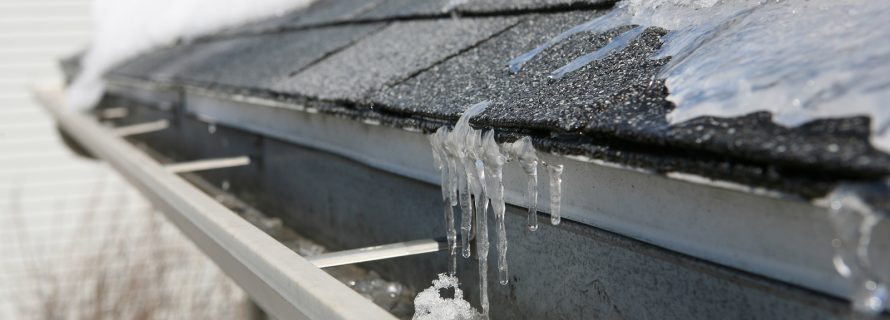What is an ice dam and how can I prevent it?

Winter weather may look beautiful out your window, but it can cause serious problems for your home. Many homeowners unfortunately deal with ice dams – a wall of ice that builds up at the edge of your roof and prevents water from draining properly. When melting snow or ice can’t get off the roof, it pools behind the dam and eventually soaks into your roof under the shingles and through cracks leading to damage on your roof, insulation, attic and home’s interior.
How ice dams are made
The science of how an ice dam is created is not complex – for starters dams are most likely to occur during times when there are below-freezing temperatures and plenty of precipitation. When snow hits your roof, it will melt because the temperature of your house is warmer than outdoors. As this water runs down your roof, it eventually hits the eaves or overhang that isn’t heated by your house below. This part of the roof is the same temperature as outside and leads the water to freeze. As more water runs down, more water freezes on the edge of the roof. This creates a growing ice dam that holds more and more snow and water on your roof, leading to an increased likelihood of leaks and water damage.

Ice dams can occur on a variety of roof styles.
How can I tell if I have an ice dam?
The first sign of ice dams is seeing long & thick icicles. While small icicles are unavoidable, icicles that are more than an inch in diameter can be a sign of an ice dam. Additionally, if you suspect you have an ice dam but see few signs outside, check the area inside your house that is most likely to be damaged. If your dam has let water leak in, you’ll have stains and puddles as indicative signs. Unfortunately, if your home has received a lot of snow it can be difficult to see your whole roof so be sure to consistently look for tell-tale signs.
Ventilate your Eaves and Ridge – A ridge vent paired with continuous soffit vents circulates cold air under the entire roof. Both ridge and soffit vents should have the same size openings and provide at least 1 square foot of opening for every 300 square feet of attic floor. Place baffles at the eaves to maintain a clear path for the airflow from the soffit vents.
How can I prevent ice dams?
- Close all Openings – Openings in your roof such as fans are major openings for heat to escape so be sure to seal them with weather-stripping made with foil-faced foam board held together with aluminum tape.
- Exhaust to the Outside – Make sure that the ducts connected to your kitchen, bathroom, and dryer vents all lead outdoors through either the roof or walls, but never through the soffit.
- Add Insulation – The more insulation on the attic floor the more heat that will stay within your homes living space.
- Install Sealed Can Lights – Old-style recessed lights give off great plumes of heat and can’t be insulated without creating a fire hazard. Replace them with sealed “IC” fixtures, which can be covered with insulation.
- Insulate Ducts – Be sure that all ducts using appropriate duct tape, duct paintable sealant, duct caulk, duct insulation, etc.
- Seal Cables and Pipes – Seal around electrical cables and vent pipes with a fire-stop sealant. Also, look for any spots where light shines up from below or the insulation is stained black by the dirt from passing air.
What should I do if I find an Ice Dam?
If you find yourself facing an ice dam in the middle of a storm, there are a few ways that you can reduce its damage. People use specialty rakes to clean the snow and ice off their roof during and after a storm to eliminate the buildup of precipitation therefore there will be minimal water/ice build up to allow ice damming to occur.
If water is leaking inside, you can crack the dam to let the water out however this may cause additional damage to your roof, fascia, and or gutter so be sure to be careful or consult a professional contractor as professionals often use steam. There are some known home remedies that you can use including the use salt or kitty litter in pantyhose to eat away at the ice and melt it. All of these quick fixes can work in an emergency, but none are ideal.
Often, by the time you address an ice dam, there’s already some damage to the home so be sure to invest in an ice rake and consult with an exterior designer to create permanent fixes for ice dams and address any damage that has already developed.
- Additions and New Construction
- All Exteriors
- Alterations
- Basements
- Bathrooms
- Customer Service
- Customer Stories
- Decks
- Design & Planning Show
- DIY
- Doors
- Educational Resources
- Extreme Makeover Home Edition
- Fashion Show
- General Remodeling
- Green Living
- Handyman Home Services
- Home Decor
- Home Entertainment
- Home Improvement
- Home Improvements
- How to Tips
- In The Community
- Kitchens
- Off-the-Wall Remodeling Stories
- Remodeling
- Resources
- Roofing
- Siding
- Social Media
- Sunrooms
- Tips & Tricks
- Trends
- Windows

